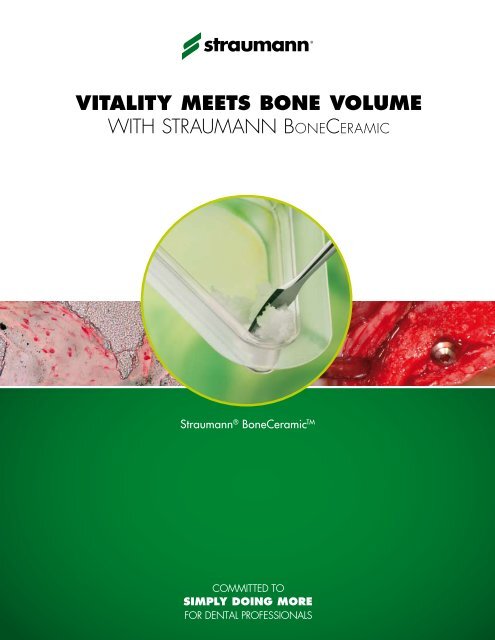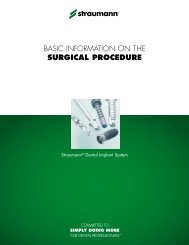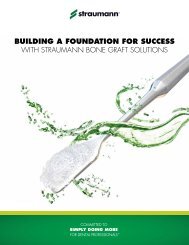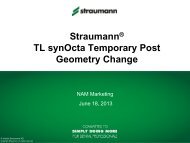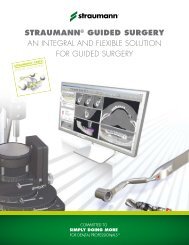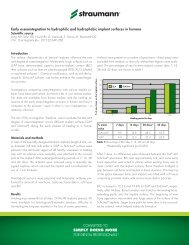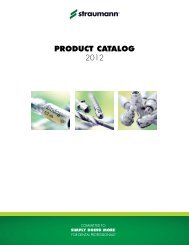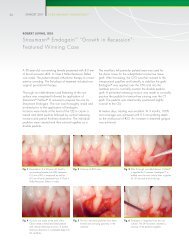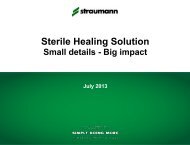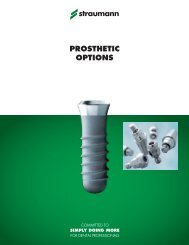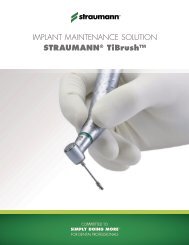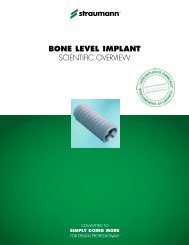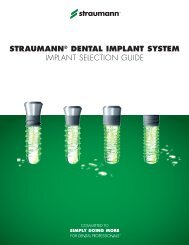LIT262 Bone Ceramic Vitality Brochure - Straumann
LIT262 Bone Ceramic Vitality Brochure - Straumann
LIT262 Bone Ceramic Vitality Brochure - Straumann
You also want an ePaper? Increase the reach of your titles
YUMPU automatically turns print PDFs into web optimized ePapers that Google loves.
vitality meets bone volume<br />
WITH STRAUMANN Bon eCe r a m ic<br />
<strong>Straumann</strong> ® <strong>Bone</strong><strong>Ceramic</strong> TM
The vitality you need<br />
around dental implants<br />
<strong>Bone</strong> volume restoration and<br />
PReservation for the desired<br />
esthetic outcome<br />
Image by PD Dr. F. Schwarz<br />
Image by Dr. N. Van Assche<br />
Patient’s own bone regeneration is a key factor to<br />
successful osseointegration of dental implants.<br />
<strong>Straumann</strong> ® <strong>Bone</strong><strong>Ceramic</strong> TM gradually resorbs and<br />
becomes substituted by new vital bone.<br />
<strong>Bone</strong> volume restoration and preservation are essential<br />
requirements in order to achieve esthetic results successfully.<br />
<strong>Straumann</strong> <strong>Bone</strong><strong>Ceramic</strong> is engineered to support<br />
resto ration and preservation of bone volume.<br />
1
<strong>Bone</strong> formation accompanies<br />
<strong>Straumann</strong> <strong>Bone</strong><strong>Ceramic</strong> degradation<br />
<strong>Bone</strong> formation accompanies <strong>Straumann</strong> ® <strong>Bone</strong><strong>Ceramic</strong> TM degradation in vivo 1,2<br />
NMT<br />
NMB<br />
SBC<br />
Image by PD Dr. F. Schwarz. Methyl Green staining, original magnification X 400<br />
NMB: new mineralized bone<br />
NMT: non mineralized tissue displaying osteogenetic activity<br />
SBC: <strong>Straumann</strong> <strong>Bone</strong><strong>Ceramic</strong> particle<br />
Arrows: <strong>Straumann</strong> <strong>Bone</strong><strong>Ceramic</strong> degradation (grey zones)<br />
Images and data from a preclinical canine study by PD Dr. F. Schwarz.<br />
Data on file. 2<br />
2<br />
1,2<br />
see studies overview on page 8
Osteoid<br />
Sustained bone formation<br />
over healing time<br />
Antigenic reactivity indicating<br />
bone formation over time<br />
SBC<br />
Image by PD Dr. F. Schwarz. Collagen type I<br />
staining, original magnification X 400<br />
Osteoblasts<br />
Collagen I fibres<br />
(arrow), a major<br />
component of<br />
the bone matrix,<br />
clearly indicate<br />
osteogenesis.<br />
Mean antigenic reactivity (%)<br />
50<br />
40<br />
30<br />
20<br />
10<br />
0<br />
1 week<br />
4 weeks 9 weeks<br />
NFB<br />
SBC<br />
Image by PD Dr. F. Schwarz. Osteocalcin staining,<br />
original magnification X 400<br />
Osteoblasts<br />
(arrow), cells<br />
responsible for<br />
bone synthesis,<br />
present in the<br />
new forming<br />
bone (NFB).<br />
Collagen type I formation<br />
<strong>Bone</strong> synthesis<br />
Blood vessel formation<br />
Blood vessels<br />
BV<br />
Image by PD Dr. F. Schwarz. Transglutaminase II<br />
staining, original magnification X 400<br />
Blood vessels (BV)<br />
grow through<br />
<strong>Straumann</strong> ®<br />
<strong>Bone</strong><strong>Ceramic</strong> TM<br />
augmented bone<br />
supplying nutrients<br />
for bone generation.<br />
3
Designed to PROMOTE GROWTH OF Patient's own bone<br />
<strong>Straumann</strong> <strong>Bone</strong><strong>Ceramic</strong><br />
Significantly less residual bone<br />
substitute and more non-mineralized<br />
tissue (including bone marrow and<br />
connective tissue) with <strong>Straumann</strong> ®<br />
<strong>Bone</strong><strong>Ceramic</strong> TM , compared to<br />
bovine bone mineral, 6–7 months<br />
post augmentation, in sinus floor<br />
elevation 3<br />
Equivalent new mineralized bone,<br />
in comparison to bovine bone<br />
mineral 3<br />
Both <strong>Straumann</strong> <strong>Bone</strong><strong>Ceramic</strong><br />
and bovine bone mineral are<br />
materials suitable for sinus<br />
augmentation followed by<br />
placement of dental implants<br />
Percentage of augmented area<br />
%<br />
100<br />
90<br />
80<br />
70<br />
60<br />
50<br />
40<br />
30<br />
20<br />
10<br />
0<br />
Native<br />
bone<br />
58%<br />
42%<br />
26.6%<br />
51.8%<br />
21.6%<br />
<strong>Straumann</strong><br />
<strong>Bone</strong><strong>Ceramic</strong><br />
37.7%<br />
42.5%<br />
19.8%<br />
Bovine bone<br />
mineral<br />
Composition of regenerated tissue 6–7 months<br />
post augmentation<br />
<strong>Bone</strong> substitute<br />
Non-mineralized tissue<br />
Mineralized bone<br />
28.35 % average newly formed<br />
mineralized bone with <strong>Straumann</strong><br />
<strong>Bone</strong><strong>Ceramic</strong> versus 22.27 % with<br />
bovine bone mineral, between<br />
6 and 8 months post augmentation<br />
(p = 0.6024) 4<br />
NMB<br />
NMB: New mineralized bone<br />
SBC: <strong>Straumann</strong> <strong>Bone</strong><strong>Ceramic</strong><br />
Osteoid: green staining<br />
Trend of increase in mineral bone<br />
formation over healing time with<br />
<strong>Straumann</strong> <strong>Bone</strong><strong>Ceramic</strong> 4<br />
SBC<br />
<strong>Bone</strong> vitality was 100% in all<br />
cores harvested 4<br />
Significant increase in mean<br />
bone area fraction over healing time<br />
with <strong>Straumann</strong> <strong>Bone</strong><strong>Ceramic</strong> in a<br />
mixed with autogenous bone,<br />
in sinus floor elevation 5<br />
Image by Prof. Dr. S.J. Froum. Stevenel´s blue and<br />
Van Gieson´s picro fuchsin, magnification X 200<br />
Reproduction authorized by International<br />
Journal of Periodontics & Restorative Dentistry<br />
Percentage of augmented area<br />
%<br />
50<br />
45<br />
40<br />
35<br />
30<br />
25<br />
20<br />
15<br />
10<br />
28.6% 25.5% 41.6% 23.5%<br />
<strong>Bone</strong><br />
Particles<br />
5<br />
0<br />
6 months 9 months<br />
Mean bone area fraction, 6 and 9 months<br />
post augmentation<br />
4<br />
3,4,5<br />
see studies overview on page 8<br />
Polarized image displays osseointegration of<br />
<strong>Straumann</strong> <strong>Bone</strong><strong>Ceramic</strong> particle in lamellar type<br />
of bone, 6 months post augmentation<br />
Image by Prof. Dr. Z. Artzi. Paragon staining,<br />
original magnification X 600<br />
Reproduction authorized by Clin. Oral Impl. Res
<strong>Bone</strong> volume restoration and preservation<br />
for the desired esthetic outcome<br />
1.<br />
2.<br />
Dehiscence-type defect before and 6 months after<br />
augmentation with <strong>Straumann</strong> <strong>Bone</strong><strong>Ceramic</strong><br />
Image by Dr. N. Van Assche<br />
Periapical radiograph before treatment and<br />
12 months after augmentation procedure<br />
Image by Prof. Dr. G.-G. K. Zafiropoulos<br />
Reproduction authorized by J. Periodontology<br />
1. Extraction socket filled with <strong>Straumann</strong><br />
<strong>Bone</strong><strong>Ceramic</strong><br />
2. <strong>Bone</strong> volume restoration 8 months post<br />
augmentation<br />
Images by Dr. N. Mardas and Prof. N. Donos<br />
In a prospective randomized<br />
controlled clinical study,<br />
<strong>Straumann</strong> ® <strong>Bone</strong><strong>Ceramic</strong> TM in<br />
combination with autogenous<br />
bone has been observed to<br />
successfully promote the<br />
restoration of bone volume in<br />
dehiscence-type defects. 6<br />
Equivalent defect fill as compared to<br />
bovine bone mineral 6 months after<br />
augmen tation. 6<br />
6,7,8<br />
see studies overview on page 8<br />
Significantly greater gain of<br />
clinical attachment and hard<br />
tissue formation with <strong>Straumann</strong><br />
<strong>Bone</strong><strong>Ceramic</strong> compared to<br />
autogenous bone alone in<br />
interproximal intrabony defects. 7<br />
Equivalent vertical bone growth and<br />
relative bone gain compared to<br />
bovine bone mineral 12 months post<br />
augmentation. 7<br />
In a prospective randomized<br />
controlled clinical study,<br />
<strong>Straumann</strong> <strong>Bone</strong><strong>Ceramic</strong>, in tooth<br />
extraction sockets, successfully<br />
supported ridge dimensions preservation.<br />
8<br />
Statistically significant less reduction in<br />
the bucco-lingual ridge dimension with<br />
<strong>Straumann</strong> <strong>Bone</strong><strong>Ceramic</strong> than with<br />
bovine bone mineral, 8 months post<br />
augmentation. Equivalent width of the<br />
buccal and palatal/lingual bone plate<br />
and equivalent distance (height) of the<br />
alveolar bone crest at the mesial- and<br />
distal-central aspects of the socket<br />
relative to the CEJ of neighboring teeth,<br />
with <strong>Straumann</strong> <strong>Bone</strong><strong>Ceramic</strong><br />
compared to bovine bone mineral,<br />
8 months post augmentation. 8<br />
5
<strong>Straumann</strong> <strong>Bone</strong><strong>Ceramic</strong><br />
Excellent handling, reproducible quality<br />
<strong>Straumann</strong> ® <strong>Bone</strong><strong>Ceramic</strong> TM is a fully synthetic and biocompatible product. Its manufacturing process is engineered to result<br />
in homogeneous phase distribution to support homogeneous resorption. The synthetic nature of <strong>Straumann</strong> <strong>Bone</strong><strong>Ceramic</strong><br />
together with a controlled production process guarantee quality consistency and batch-to-batch reproducibility.<br />
<strong>Straumann</strong> <strong>Bone</strong><strong>Ceramic</strong> rapidly absorbs fluids, forming a granular putty. The wetted granules adhere to the application<br />
instrument and sub sequently fit the bony defect. <strong>Straumann</strong> <strong>Bone</strong><strong>Ceramic</strong> mixes well with sterile saline solution, autogenous<br />
blood and bone.<br />
Ordering information<br />
Art. No. Article Dimensions<br />
070.203 <strong>Straumann</strong> <strong>Bone</strong><strong>Ceramic</strong> 400 – 700 Granule size: 400 – 700 microns<br />
Unit size: 0.25 g<br />
Volume: approx. 0.3 ml<br />
070.204 <strong>Straumann</strong> <strong>Bone</strong><strong>Ceramic</strong> 500 – 1000 Granule size: 500 – 1000 microns<br />
Unit size: 0.5 g<br />
Volume: approx. 0.95 ml<br />
070.205 <strong>Straumann</strong> <strong>Bone</strong><strong>Ceramic</strong> 500 – 1000 Granule size: 500 – 1000 microns<br />
Unit size: 1 g<br />
Volume: approx. 1.9 ml<br />
6
Technical sheet<br />
<strong>Straumann</strong> ® <strong>Bone</strong><strong>Ceramic</strong> TM is a fully synthetic bone graft substitute indicated for filling<br />
and/or augmenting intraoral/maxillofacial osseous defects:<br />
bony defects of the alveolar ridge<br />
tooth extraction sites<br />
sinus floor elevation<br />
intrabony periodontal osseous defects and furcation<br />
Optimized morphology<br />
With its optimized porosity, <strong>Straumann</strong> <strong>Bone</strong><strong>Ceramic</strong> is designed to favor vascularization, osteoblast migration and bone<br />
deposition. High porosity and minimum amount of material leave maximum space for new bone.<br />
Gradual resorption<br />
<strong>Straumann</strong> <strong>Bone</strong><strong>Ceramic</strong> consists of hydroxylapatite and -tricalcium phosphate in a homogenous com posite.<br />
-tricalcium phosphate resorbs faster than hydroxylapatite, becoming replaced by natural bone. Hydroxy lapatite prevents<br />
excessive resorption and preserves bone volume which are critical to achieving a successful esthetic result 9 .<br />
Reproducible quality and safety of synthetic products<br />
<strong>Straumann</strong> <strong>Bone</strong><strong>Ceramic</strong> is a fully synthetic and biocompatible material. It mixes well with sterile saline solution,<br />
autogenous blood or bone. <strong>Straumann</strong> <strong>Bone</strong><strong>Ceramic</strong> rapidly absorbs fluids, forming a granular putty which adheres<br />
to the application instrument and fits the bony defect.<br />
Biphasic calcium phosphate<br />
60 % hydroxylapatite<br />
40 % -tricalcium phosphate<br />
HA<br />
TCP<br />
High porosity<br />
Total porosity: 90 %<br />
Interconnected pores<br />
Pores size: 100–500 µm<br />
Granule dimensions<br />
Two available granule sizes<br />
400–700 µm<br />
500–1000 µm<br />
Excellent wettability and handling<br />
Absorbs fluids, forming a granular putty<br />
Adheres to the application instrument<br />
Conforms to the bony defect<br />
9<br />
see studies overview on page 8<br />
7
studies<br />
<strong>Straumann</strong> <strong>Bone</strong><strong>Ceramic</strong><br />
Reference Study Type Indication<br />
1 Schwarz F et al. Guided bone regeneration at dehiscencetype<br />
defects using biphasic hydroxyapatite + beta tricalcium<br />
phosphate (<strong>Bone</strong><strong>Ceramic</strong>) or a collagen-coated natural<br />
bone mineral (Bio-Oss ® Collagen): an immunohistochemical<br />
study in dogs. Int J Oral Maxillofac Surg. 2007 Dec;<br />
36(12): 1198-1206.<br />
Preclinical canine study<br />
6 animals, 24 dehiscence-type defects<br />
Split mouth design<br />
Use of a resorbable membrane<br />
Dehiscencetype<br />
defects<br />
2 Schwarz F et al. Immunohistochemical characterization<br />
of wound healing at two different bone graft substitutes.<br />
A pilot study in dogs. Data on file.<br />
Preclinical canine study<br />
Split mouth design<br />
6 animals, 24 dehiscence-type defects<br />
Use of a resorbable membrane<br />
Dehiscencetype<br />
defects<br />
3 Cordaro L et al. Maxillary sinus grafting with Bio-Oss or<br />
<strong>Straumann</strong> ® <strong>Bone</strong><strong>Ceramic</strong> TM : histomorphometric results from<br />
a randomized controlled multicenter clinical trial. Clin Oral<br />
Implants Res. 2008 Aug; 19(8): 796-803.<br />
Prospective, randomized, multicenter clinical<br />
study<br />
37 patients, 48 sinus floor elevation procedures<br />
Use of a collagen resorbable membrane<br />
Sinus floor<br />
elevation<br />
4 Froum SJ et al. Histomorphometric comparison of a biphasic<br />
bone ceramic to anorganic bovine bone for sinus augmentation:<br />
6- to 8- month postsurgical assessment of vital bone<br />
formation. A pilot study. Int J Periodontics Restorative Dent.<br />
2008 Jun; 28(3): 273-81.<br />
Prospective, blinded, randomized,<br />
controlled pilot study<br />
Split mouth design<br />
12 patients, 21 sinus floor elevation procedures<br />
Use of a collagen resorbable membrane<br />
Sinus floor<br />
elevation<br />
5 Artzi Z et al. Histomorphometric assessment of bone<br />
formation in sinus augmentation utilizing a combination<br />
of autogenous and hydroxyapatite/biphasic tricalcium<br />
phosphate graft materials: at 6 and 9 months in humans.<br />
Clin Oral Implants Res. 2008 Jul; 19(7): 686-92.<br />
Prospective clinical study<br />
28 patients, 28 sinus floor elevation procedures<br />
In combination with autogenous bone<br />
Use of a collagen resorbable membrane<br />
Sinus floor<br />
elevation<br />
6 van Assche N et al. <strong>Bone</strong><strong>Ceramic</strong> as alternative for<br />
Bio-Oss in the treatment of bony dehiscencies along<br />
implants. EAO 2007. Data on file.<br />
Prospective, randomized controlled clinical<br />
study<br />
Split mouth design<br />
14 patients, 28 extraction sockets<br />
In combination with autogenous bone<br />
Use of a collagen resorbable membrane<br />
Dehiscencetype<br />
defects<br />
7 Zafiropoulos GG et al. Treatment of intrabony defects using<br />
guided tissue regeneration and autogenous spongiosa<br />
alone or combined with hydroxyapatite/beta-tricalcium<br />
phosphate bone substitute or bovine-derived xenograft.<br />
J Periodontol. 2007 Nov; 78(11): 2216-25.<br />
Single-masked, non-randomized, case-control<br />
clinical study<br />
65 patients, 93 intrabony defects<br />
In combination with autogenous bone<br />
Use of a resorbable membrane<br />
Periodontal<br />
intrabony<br />
defects<br />
8 Mardas N et al. Socket preservation with synthetic bone<br />
substitute or a bovine xenograft.<br />
IADR 2008. Data on file.<br />
Prospective, single blind, randomized, controlled<br />
clinical study<br />
26 patients, 26 extraction sockets<br />
Use of a resorbable membrane<br />
Alveolar ridge<br />
dimensions<br />
preservation<br />
9 Jensen SS et al. Evaluation of a novel biphasic calcium<br />
phosphate in standardized bone defects: a histologic and<br />
histomorphometric study in the mandibles of minipigs. Clin<br />
Oral Implants Res. 2007 Dec; 18(6): 752-60.<br />
Preclinical study in minipigs<br />
16 animals, 128 mandibular bony defects<br />
Use of a non resorbable membrane<br />
Mandibular<br />
bony defects<br />
8<br />
Bio-Oss ® Collagen is a registered trademark of Osteomedical Ltd. CORPORATION IRELAND 41 Central Chambers Dame Court, Dublin 2 IRELAND
Three reasons to choose <strong>Straumann</strong> ® <strong>Bone</strong><strong>Ceramic</strong> TM<br />
<strong>Bone</strong> vitality that is critical<br />
around dental implants<br />
International Headquarters<br />
Institut <strong>Straumann</strong> AG<br />
Peter Merian-Weg 12<br />
CH-4002 Basel, Switzerland<br />
Phone +41 (0)61 965 11 11<br />
Fax +41 (0)61 965 11 01<br />
<strong>Bone</strong> volume restoration and<br />
preservation are critical for<br />
the desired esthetic outcome<br />
Excellent handling,<br />
reproducible quality<br />
www.straumann.com<br />
North American Distributors<br />
<strong>Straumann</strong> USA, LLC<br />
60 Minuteman Road<br />
Andover, MA 01810<br />
Phone 800/448 8168<br />
978/747 2500<br />
Fax 978/747 2490<br />
www.straumannusa.com<br />
<strong>Straumann</strong> Canada Limited<br />
4145 North Service Road, Suite 303<br />
Burlington, ON L7L 6A3<br />
Phone 800/363 4024<br />
905/319 2900<br />
Fax 905/319 2911<br />
www.straumann.ca<br />
<strong>Straumann</strong> products are CE marked 1/09 USLIT 262<br />
© <strong>Straumann</strong> USA, LLC 2008. All rights reserved. <strong>Straumann</strong> ® and/or other trademarks and logos from <strong>Straumann</strong> ® that are<br />
mentioned here are the trademarks or registered trademarks of <strong>Straumann</strong> Holding AG and/or its affiliates. All rights reserved.


